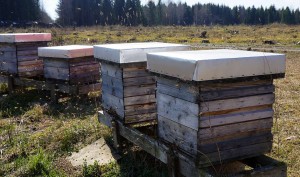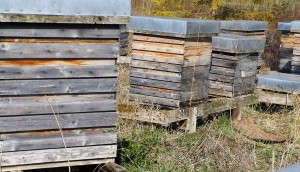Second day checking for increase after winter I now came to some apiaries inside my Elgon area and almost all colonies needed a super above the excluder. The weather had turned warm after winter and the colonies demanded me to come to them in spite of the holiday, so I checked a couple of apiaries yesterday.
 Just entered the apiary. Before the increase. Tussilago “field” in the background. Notice the heap of dead bees at the end of the cardboard in front of the hive. A good strong colony cleans the bottom board after winter itself. Soon I will check inside the colonies and put on a super above an excluder above the third box. The colony on two boxes is the one dwindling.
Just entered the apiary. Before the increase. Tussilago “field” in the background. Notice the heap of dead bees at the end of the cardboard in front of the hive. A good strong colony cleans the bottom board after winter itself. Soon I will check inside the colonies and put on a super above an excluder above the third box. The colony on two boxes is the one dwindling.
One colony in each apiary was dwindling and got a few grams of thymol, in first place to kill some mites so eventual robbing or drifting shouldn’t spread more mites than necessary. If it survives I will shift the queen later on. I didn’t see any wingless bees. But something was wrong as they were dwindling. Shotgun pattern of brood also indicated mites. Could be just an old queen. No AFB. Glad for that. Havn’t had for years.
 Cardboards in front of the hives are cleaned, ready to be checked later at visits, checking what the bees have dragged out, or other eventual interesting things to be seen there. Excluder and supers are on almost all colonies, now ready for the winter rape to start blooming in a week or two. At next visit some colonies may well need a second super.
Cardboards in front of the hives are cleaned, ready to be checked later at visits, checking what the bees have dragged out, or other eventual interesting things to be seen there. Excluder and supers are on almost all colonies, now ready for the winter rape to start blooming in a week or two. At next visit some colonies may well need a second super.
At one of the apiaries a big area of fir trees were cut down and I had wondered how the bees would react on more sun and a lot more wind. They seem to handle the different circumstances well. A nice thing is the big areas with a very good spring plant for pollen and nectar, Tussilago farfara, like golden fields of them. Never seen that much of them before. Bees were eager for both nectar and pollen in the nice weather.

Greetings Erik,
Yesterday, I helped a friend make up nucs for sale. As we travelled to his yards, I saw patches of this plant in bloom. We call it coltsfoot.
Gregory
The Swedish name is about the same (translated). Interesting it’s blooming the same time as I’m much further to the north than you. I’m at 59° latitude. But the maple is just about to start now, three weeks early actually.